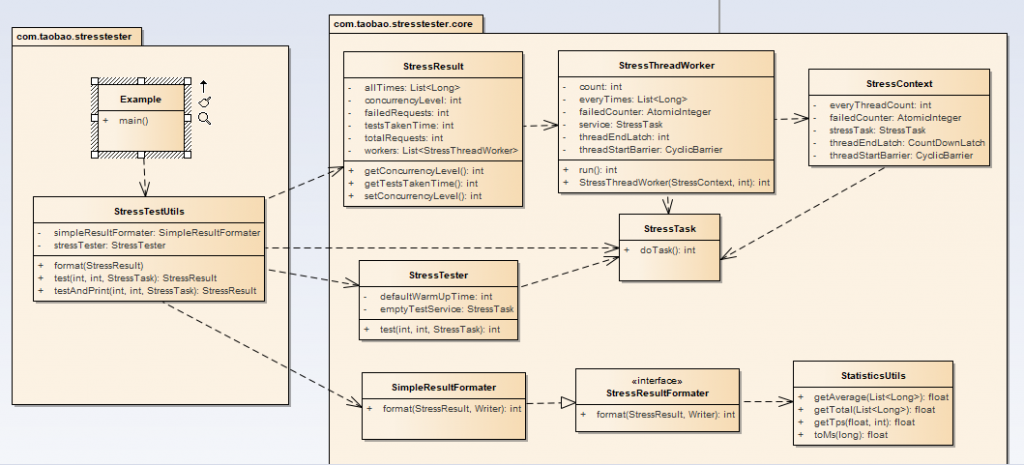stresstester源码分析
写在前面
stresstester-1.0.jar是早期淘宝的一个压力测试工具,很方便开发人员进行本地代码的压力测试,其他专门压力测试工具也有很多,如:jmeter loadrunner 等等,本篇文章主要讲一下stresstester的源码设计先来张类图
 从上图可以看出StressTestUtils是和开发者打交道的最主要的类;下面来个例子
从上图可以看出StressTestUtils是和开发者打交道的最主要的类;下面来个例子
package com.taobao.stresstester; import com.taobao.stresstester.core.StressTask; import java.io.PrintStream; public class Example { public static void main(String[] args) { StressTestUtils.testAndPrint(100, 1000, new StressTask() { public Object doTask() throws Exception { System.out.println("Do my task."); return null; } }); } }下面我来介绍主要原理吧: 1.开启多线程去跑目标代码(每个线程访问的次数=总请求次数/并发数)
public StressResult test(int concurrencyLevel, int totalRequests, StressTask stressTask, int warmUpTime) { if (stressTask == null) { stressTask = this.emptyTestService; } warmUp(warmUpTime, stressTask); int everyThreadCount = totalRequests / concurrencyLevel; CyclicBarrier threadStartBarrier = new CyclicBarrier(concurrencyLevel); CountDownLatch threadEndLatch = new CountDownLatch(concurrencyLevel); AtomicInteger failedCounter = new AtomicInteger(); StressContext stressContext = new StressContext(); stressContext.setTestService(stressTask); stressContext.setEveryThreadCount(everyThreadCount); stressContext.setThreadStartBarrier(threadStartBarrier); stressContext.setThreadEndLatch(threadEndLatch); stressContext.setFailedCounter(failedCounter); ExecutorService executorService = Executors.newFixedThreadPool(concurrencyLevel); List<StressThreadWorker> workers = new ArrayList(concurrencyLevel); for (int i = 0; i < concurrencyLevel; i++) { StressThreadWorker worker = new StressThreadWorker(stressContext, everyThreadCount); workers.add(worker); } for (int i = 0; i < concurrencyLevel; i++) { StressThreadWorker worker = (StressThreadWorker)workers.get(i); executorService.submit(worker); } try { threadEndLatch.await(); } catch (InterruptedException e) { log.error("InterruptedException", e); } executorService.shutdownNow(); int realTotalRequests = everyThreadCount * concurrencyLevel; int failedRequests = failedCounter.get(); StressResult stressResult = new StressResult(); SortResult sortResult = getSortedTimes(workers); List<Long> allTimes = sortResult.allTimes; stressResult.setAllTimes(allTimes); List<Long> trheadTimes = sortResult.trheadTimes; long totalTime = ((Long)trheadTimes.get(trheadTimes.size() - 1)).longValue(); stressResult.setTestsTakenTime(totalTime); stressResult.setFailedRequests(failedRequests); stressResult.setTotalRequests(realTotalRequests); stressResult.setConcurrencyLevel(concurrencyLevel); stressResult.setWorkers(workers); return stressResult; }为什么要用2个同步辅助类CyclicBarrier,CountDownLatch
//设置线程集合点,等所有现存启动完毕在一起请求任务 CyclicBarrier threadStartBarrier = new CyclicBarrier(concurrencyLevel); //控制所有线程做完任务后状态,数量为0的时间,所有任务执行完毕 CountDownLatch threadEndLatch = new CountDownLatch(concurrencyLevel);2.记录每次调用代码的时间,放到一个集合中
SortResult sortResult = getSortedTimes(workers); List<Long> allTimes = sortResult.allTimes;3.计算打印出tps /平均耗时/最短耗时/最长耗时
TPS=并发数/平均的相应时间 平均响应时间=测试总时间/总请求次数
package com.taobao.stresstester.core; import java.io.IOException; import java.io.Writer; import java.util.List; import org.slf4j.Logger; import org.slf4j.LoggerFactory; public class SimpleResultFormater implements StressResultFormater { protected static Logger log = LoggerFactory.getLogger(SimpleResultFormater.class); public void format(StressResult stressResult, Writer writer) { long testsTakenTime = stressResult.getTestsTakenTime(); int totalRequests = stressResult.getTotalRequests(); int concurrencyLevel = stressResult.getConcurrencyLevel(); float takes = StatisticsUtils.toMs(testsTakenTime); List<Long> allTimes = stressResult.getAllTimes(); long totaleTimes = StatisticsUtils.getTotal(allTimes); float tps = 1.0E+009F * (concurrencyLevel * (totalRequests / (float)totaleTimes)); float averageTime = StatisticsUtils.getAverage(totaleTimes, totalRequests); float onTheadAverageTime = averageTime / concurrencyLevel; int count_50 = totalRequests / 2; int count_66 = totalRequests * 66 / 100; int count_75 = totalRequests * 75 / 100; int count_80 = totalRequests * 80 / 100; int count_90 = totalRequests * 90 / 100; int count_95 = totalRequests * 95 / 100; int count_98 = totalRequests * 98 / 100; int count_99 = totalRequests * 99 / 100; long longestRequest = ((Long)allTimes.get(allTimes.size() - 1)).longValue(); long shortestRequest = ((Long)allTimes.get(0)).longValue(); StringBuilder view = new StringBuilder(); view.append(" Concurrency Level:\t").append(concurrencyLevel) .append("--并发数"); view.append("\r\n Time taken for tests:\t").append(takes).append(" ms") .append("--测试耗时"); view.append("\r\n Complete Requests:\t").append(totalRequests) .append("--完成测试次数"); view.append("\r\n Failed Requests:\t") .append(stressResult.getFailedRequests()).append("--失败次数"); view.append("\r\n Requests per second:\t").append(tps).append("--QPS"); view.append("\r\n Time per request:\t") .append(StatisticsUtils.toMs(averageTime)).append(" ms") .append("--平均耗时"); view.append("\r\n Time per request:\t") .append(StatisticsUtils.toMs(onTheadAverageTime)) .append(" ms (across all concurrent requests)") .append("--平均耗时,忽略并发影响"); view.append("\r\n Shortest request:\t") .append(StatisticsUtils.toMs(shortestRequest)).append(" ms") .append("--最短耗时"); StringBuilder certainTimeView = view; certainTimeView .append("\r\n Percentage of the requests served within a certain time (ms)"); certainTimeView.append("\r\n 50%\t") .append(StatisticsUtils.toMs(((Long)allTimes.get(count_50)).longValue())) .append("--50% 的耗时在0.005703毫秒以下"); certainTimeView.append("\r\n 66%\t").append( StatisticsUtils.toMs(((Long)allTimes.get(count_66)).longValue())); certainTimeView.append("\r\n 75%\t").append( StatisticsUtils.toMs(((Long)allTimes.get(count_75)).longValue())); certainTimeView.append("\r\n 80%\t").append( StatisticsUtils.toMs(((Long)allTimes.get(count_80)).longValue())); certainTimeView.append("\r\n 90%\t").append( StatisticsUtils.toMs(((Long)allTimes.get(count_90)).longValue())); certainTimeView.append("\r\n 95%\t").append( StatisticsUtils.toMs(((Long)allTimes.get(count_95)).longValue())); certainTimeView.append("\r\n 98%\t").append( StatisticsUtils.toMs(((Long)allTimes.get(count_98)).longValue())); certainTimeView.append("\r\n 99%\t").append( StatisticsUtils.toMs(((Long)allTimes.get(count_99)).longValue())); certainTimeView.append("\r\n 100%\t") .append(StatisticsUtils.toMs(longestRequest)) .append(" (longest request)").append("--最长的耗时"); try { writer.write(view.toString()); } catch (IOException e) { log.error("IOException:", e); } } }今天讲解到此结束 enjoy it!
正文到此结束
- 本文标签: stresstester
- 版权声明: 本文由HARRIES原创发布,转载请遵循《署名-非商业性使用-相同方式共享 4.0 国际 (CC BY-NC-SA 4.0)》许可协议授权
- 本文海报: 生成海报一 生成海报二
热门推荐
相关文章
Loading...











![[HBLOG]公众号](https://www.liuhaihua.cn/img/qrcode_gzh.jpg)

